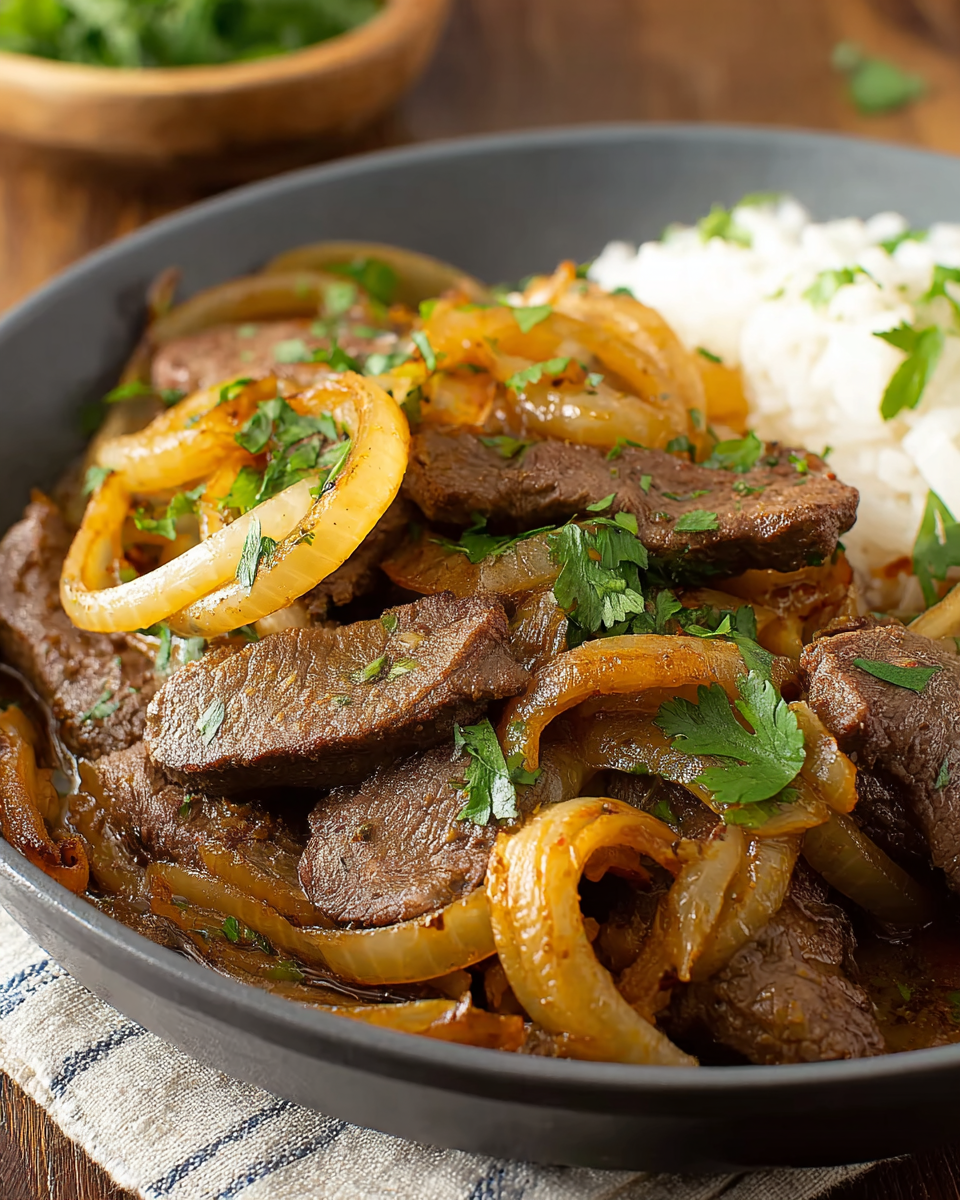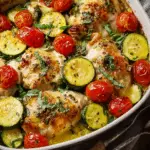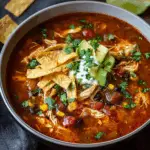Venezuelan Liver and Onions is a humble yet flavor-packed dish deeply rooted in Latin American home cooking. This dish marries thinly sliced beef liver with sweet, golden caramelized onions and a garlicky sauce that brings out the richness of the meat. It’s simple, affordable, and showcases how a few basic ingredients can be transformed into a soul-satisfying meal that resonates with family tradition and culinary heritage.
Ideal for weeknight dinners or for anyone looking to explore authentic South American flavors, this recipe is both nourishing and quick to prepare. The trick to tender liver lies in not overcooking it, and the combination of vinegar soak and Worcestershire sauce creates an exquisite balance of tanginess and savory depth. Whether paired with white rice, mashed potatoes, or arepas, this dish offers a warm taste of Venezuela on any dinner table.
Full Recipe:
Ingredients:
-
1 lb beef liver, sliced thinly
-
2 large onions, sliced into rings
-
3 cloves garlic, minced
-
2 tbsp vinegar
-
1 tbsp Worcestershire sauce
-
1/2 tsp cumin
-
1/4 tsp black pepper
-
1/2 tsp salt
-
2 tbsp vegetable oil
-
1/4 cup water
-
Fresh parsley for garnish (optional)
Directions:
-
Rinse the liver slices in cold water, then soak them in vinegar and water mixture for 10 minutes. Drain and pat dry.
-
Season the liver with salt, pepper, and cumin.
-
In a skillet over medium heat, add 1 tbsp of oil and sauté the onions until golden and soft. Set aside.
-
In the same skillet, add the remaining oil, then add garlic and liver slices. Cook for 2–3 minutes on each side until browned.
-
Return the onions to the skillet, pour in Worcestershire sauce and 1/4 cup water. Let simmer for 5–7 minutes until liver is tender and sauce thickens.
-
Serve warm, garnished with fresh parsley if desired.
Prep Time: 10 minutes | Cooking Time: 15 minutes | Total Time: 25 minutes
Kcal: 265 kcal | Servings: 4 servings
Venezuelan Liver and Onions, or Hígado Encebollado, is more than just a traditional recipe it’s a culinary symbol of home, warmth, and deep-rooted cultural identity. Found in home kitchens across the country, this dish represents the soulful simplicity and rich flavors that define Venezuelan cuisine. Though it may be unfamiliar to those outside Latin America, this humble preparation has earned a place in the heart of every Venezuelan household.
What makes this dish special is its ability to transform an inexpensive and sometimes polarizing cut of meat beef liver into a tender, flavorful, and comforting meal. When properly prepared, liver becomes an indulgent protein that pairs perfectly with the sweetness of caramelized onions and the aromatic depth of spices like cumin and garlic. Whether served alongside rice, fried plantains, or arepas, Liver and Onions brings a nostalgic sense of home-cooked comfort to the table.
A Traditional Dish with Timeless Roots
Beef liver has been a dietary staple for generations in many cultures around the world, and in Venezuela, it’s often a go-to protein for families due to its affordability and nutritional value. Rich in iron, B12, and other essential nutrients, liver is particularly appreciated in regions where food security is a concern, offering a low-cost yet nutrient-dense alternative to more expensive meats.
The origins of the Venezuelan Liver and Onions dish lie in both necessity and creativity. While the base ingredients are simple liver, onions, garlic, vinegar, and a handful of spices the technique and care with which the dish is prepared are what elevate it from a basic meal to a culinary staple. It’s a recipe that has been passed down through generations, often cooked by grandmothers and mothers as a way to nourish their families with love and tradition.
Flavor Profile: Bold, Savory, and Comforting
One of the most distinctive qualities of this dish is its layered flavor profile. Liver on its own has a strong, almost metallic taste due to its high iron content, but when it’s marinated or soaked in vinegar and paired with robust aromatics, its flavor becomes more mellow and deeply savory.
The onions are the second star of the dish. Slowly caramelized, they add a natural sweetness that balances out the richness of the liver. Garlic and cumin round out the flavor with a slightly smoky and earthy undertone. A splash of Worcestershire sauce and vinegar gives the dish a tangy depth and umami that make each bite memorable.
It’s this contrast bold, hearty liver softened by sweet, golden onions and enlivened by tangy, garlicky seasoning that creates a deeply satisfying eating experience.
Cooking Techniques That Matter
The success of liver and onions comes down to two key elements: proper preparation and mindful cooking time. Beef liver is naturally tender when cooked quickly over high heat, but it can easily become tough and chewy if overcooked. To avoid this, it’s often soaked briefly in vinegar or milk to neutralize any bitterness and to help tenderize the meat.
Searing the liver quickly locks in flavor, and adding the onions back into the skillet to simmer with the meat allows all of the flavors to mingle. Many Venezuelan cooks prefer cast iron or non-stick skillets for an even sear and better texture.
Some variations of the dish may include tomatoes, green peppers, or a splash of broth to make the sauce more gravy-like. But the most traditional version stays true to its simple roots onions, garlic, and liver, working together in harmony.
Cultural Importance and Family Connections
In Venezuela, liver and onions are far more than just a dinner option they symbolize tradition and connection. In many households, this dish evokes memories of Sunday lunches, after-school meals, or comforting plates prepared by a loving relative. It’s often one of the first savory dishes young cooks learn to make, guided by the practiced hands of their elders.
The dish also highlights a cultural philosophy of using every part of the animal a nose-to-tail respect that reflects frugality, sustainability, and gratitude. In regions where resources may be limited, liver and other organ meats are not discarded; they are transformed into nourishing, beloved meals.
Beyond individual homes, this dish is also found in local eateries known as cocinerías casual, family-run spots where traditional fare is served affordably and generously. Here, Hígado Encebollado might be offered as a daily special, often with sides of rice, black beans, fried plantains, or even yuca.
Pairing Suggestions: The Perfect Plate
To build a full Venezuelan meal around Liver and Onions, consider these traditional side dishes:
- Arepas: These versatile cornmeal patties are the cornerstone of Venezuelan cuisine. Serve them plain or stuffed for a satisfying accompaniment.
- White Rice: The mild, starchy flavor of rice balances the rich, intense flavor of liver.
- Fried Sweet Plantains: Their sweetness enhances the savory nature of the liver and adds a textural contrast.
- Caraotas Negras (Black Beans): Common in Venezuelan homes, black beans bring earthy flavor and extra protein.
- Avocado Slices: Creamy and refreshing, avocado is often served on the side to cool the palate.
Whether served with these sides or on its own, this dish always hits the spot.
Health Benefits and Nutritional Value
For those conscious about nutritional intake, beef liver is a powerhouse. It contains high levels of vitamin A, vitamin B12, iron, folate, and protein — all essential nutrients that support immune function, energy levels, and red blood cell production. For individuals who suffer from anemia or need a nutrient boost, liver can be incredibly beneficial.
That said, it should be eaten in moderation due to its high vitamin A content, which can be excessive if consumed too frequently. But when prepared properly and balanced with other foods, liver can be a smart, healthy addition to a well-rounded diet.
Modern Twists and Fusion Potential
While traditionalists prefer the classic preparation, some modern cooks have found ways to put a twist on this iconic dish. For example, liver tacos using Venezuelan-style liver and onions wrapped in corn tortillas are growing in popularity among fusion food lovers. Others might serve it on crusty bread for a Latin-inspired open-faced sandwich.
Creative pairings and presentation don’t take away from the heritage they keep it alive, introducing the dish to new audiences while respecting its roots.
Conclusion: A Dish Worth Celebrating
Venezuelan Liver and Onions is a dish that beautifully exemplifies how comfort, culture, and culinary technique can come together in a humble, affordable meal. Though it may not be a crowd-pleaser for every palate, for those who appreciate bold flavors and home-cooked authenticity, this recipe is deeply satisfying.
Beyond its taste, the dish serves as a reminder of resourcefulness, tradition, and family. It tells the story of Venezuelan kitchens where love is measured not in fancy ingredients, but in the time and care put into every plate.
So whether you’re trying it for the first time or recreating a childhood favorite, Liver and Onions is more than food it’s a legacy of flavor waiting to be shared.






